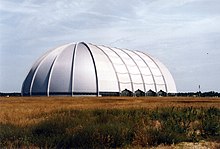Airship hangar
Airship hangars (also known as airship sheds) are large specialized buildings that are used for sheltering airships during construction, maintenance and storage. Rigid airships always needed to be based in airship hangars because weathering was a serious risk.
History
Early hangars

The first real airship hangar was built as Hangar "Y" at Chalais-Meudon near Paris in 1879 where the engineers Charles Renard and Arthur Constantin Krebs constructed their first airship "La France". Hangar "Y" is one of the few remaining airship hangars in Europe.
The construction of the first operational rigid airship LZ1 by Count Ferdinand von Zeppelin started in 1899 in a floating hangar on Lake Constance at Manzell today part of Friedrichshafen. The floating hangar turned into the direction of the wind on its own and so it was easier to move the airship into the hangar exactly against the wind.
For the same reason later rotating hangars were built at
. Already before theThe Zeppelin programme

With the construction of
UK airship construction

There was also an airship program in the UK. This required the big construction sheds in Barrow-in-Furness, Inchinnan, Barlow and Cardington, and the rigid airship war stations at Longside, East Fortune, Howden, Pulham (Norfolk) and Kingsnorth.
Today, only the two hangars of the former Royal Airship Works in Cardington, Bedfordshire, where the R101 was built, remain. The No.1 Cardington hangar is original, but extended; the No.2 hangar was relocated to Cardington from Pulham in 1928.[2]
In 1924, the Imperial Airship Communications scheme planned to extend mail and passenger service to British India, so an 859-foot hangar was constructed at Karachi (now in Pakistan) in 1929. This was the intended destination of the R101.[3]
France
In France few big hangars had been built, because there was only one attempt to build a rigid airship. Nevertheless, at the end of the
-Pierrefeu by adding the parts of smaller hangars to two big ones.At
United States



In the United States the Navy began producing non-rigid airships during
Post World War hangars

After the Second World War worldwide only one big airship shed had been built: The one in Brand south of Berlin for the construction of the
For the needs of the rather small blimps quite a number of mostly simple hangars exist around the world today.
References
Notes
- ^ Zeppelin Hangar
- ^ Bowyer (1983): Pp 94–100.
- ^ "Karachi's Airship Hangar". 9 December 2010.
Bibliography
- Bowyer, Michael J.F. (1983). Action Stations, Volume 6, Military airfields of the Cotswolds and the Central Midlands. Cambridge: Patrick Stephens. ISBN 0-85059-529-0.
Further reading
- Manfred Bauer: Luftschiffhallen in Friedrichshafen. Friedrichshafen 1985
- Kim Braun: Die Luftschiffhäfen Niedersachsens in Der Traum vom Fliegen. Oldenburg 2000
- Hein Carsens: Schiffe am Himmel – Nordholz-Geschichte eines Luftschiffhafens. Bremerhaven 1997
- Christopher Dean: Housing the Airship. London 1989
- Roland Fuhrmann: Dresden's gateway to the skies: the world's first streamlined airship hangar and its influence on architectural history. Dresden 2019 (536 pp., 770 figs.)
- Lassalle Maryse: Bases pour dirigeables. Aix-en-Provence, France 2005
- John Provan: The German Airship Sheds. Kelkheim 1988
- John Provan: Luftschiffhafen Rhein-Main. Kelkheim 1986
- John Provan: Die französischen Luftschiffhallen. Kelkheim 1989
- James R. Schock: American Airship Bases and Facilities Edgewater. Florida, USA 1996
- Dr. Fritz Strahlmann: Zwei deutsche Luftschiffhäfen des Weltkrieges – Ahlhorn und Wildeshausen. Oldenburg 1926
- Michael Wulf: Luftschiffhallen, Dissertation, Technische Universität Carola-Wilhelmina. Braunschweig 1997
External links
- (in French) Le Hangar à Dirigeables d'Ecausseville
- Hangar of Shanghai Vantage Airship Manufacture Company Limited China
- Hangar Team Augusta Italy
- The Airship Heritage Trust Cardington UK
- Navy Lakehurst Historical Society USA
- Cuers-Pierrefeu Airdrome, Cuers, France
- "Dirigible Hangar Rotates To Reduce Wind Peril" Popular Science, May 1935, futuristic idea on dirigible hangars for airline service
